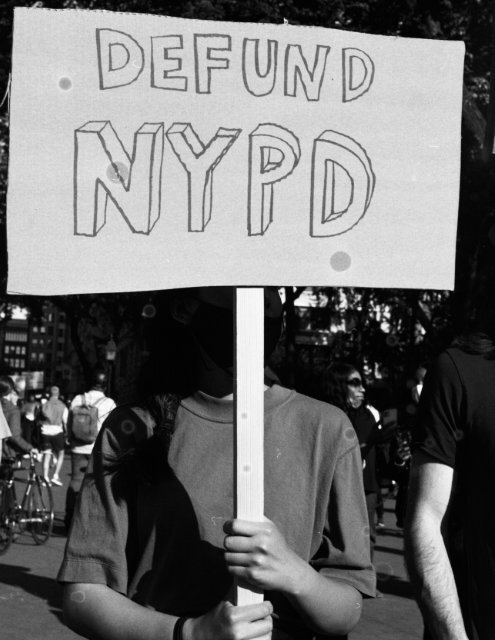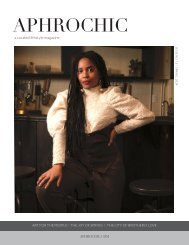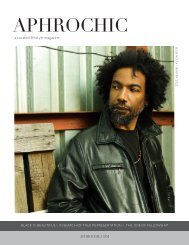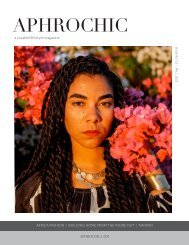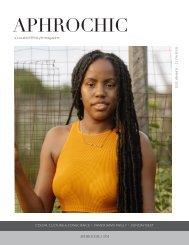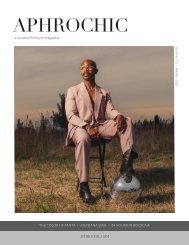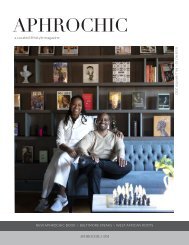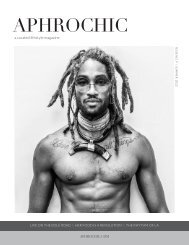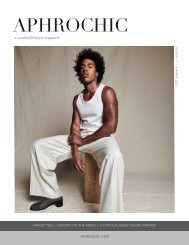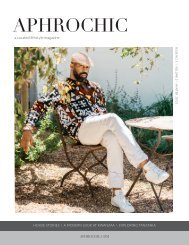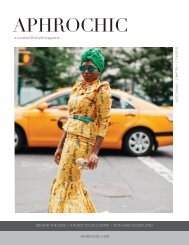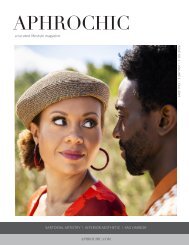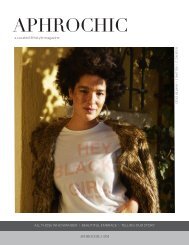AphroChic Magazine: Issue No. 4
In this issue, we sit down with artist, Malik Roberts, who relates the experience of creating one of the few African American artworks to sit permanently in the Vatican collection. Fashion designer, Prajjé Oscar John-Baptiste introduces his latest collection — an ode to Haiti, and its goddesses. We head to South Carolina to experience the Gullah-inspired music of Ranky Tanky. And in New York, we watch a new world being born with photographer and journalist, Naeem Douglass, who takes us inside the city’s Black Lives Matter protests, and economist Janelle Jones, who reminds us in these times that we are the economy. We are thrilled to share our cover with chef and musician, Lazarus Lynch. Inside, we talk with him about his cookbook, Son of a Southern Chef and his new album, I’m Gay. From a house tour in Brooklyn to a travel piece in Tobago, this issue takes you all over the Diaspora. And we see how of the concept of Diaspora was first introduced in a look back at how Pan-Africanism led the way to how we think of international Blackness today. It is a showcase of our culture, our creativity, our resilience, and our diversity, our demands for the present and our hopes for the future. Welcome to our summer issue.
In this issue, we sit down with artist, Malik Roberts, who relates the experience of creating one of the few African American artworks to sit permanently in the Vatican collection. Fashion designer, Prajjé Oscar John-Baptiste introduces his latest collection — an ode to Haiti, and its goddesses. We head to South Carolina to experience the Gullah-inspired music of Ranky Tanky. And in New York, we watch a new world being born with photographer and journalist, Naeem Douglass, who takes us inside the city’s Black Lives Matter protests, and economist Janelle Jones, who reminds us in these times that we are the economy.
We are thrilled to share our cover with chef and musician, Lazarus Lynch. Inside, we talk with him about his cookbook, Son of a Southern Chef and his new album, I’m Gay.
From a house tour in Brooklyn to a travel piece in Tobago, this issue takes you all over the Diaspora. And we see how of the concept of Diaspora was first introduced in a look back at how Pan-Africanism led the way to how we think of international Blackness today. It is a showcase of our culture, our creativity, our resilience, and our diversity, our demands for the present and our hopes for the future. Welcome to our summer issue.
Create successful ePaper yourself
Turn your PDF publications into a flip-book with our unique Google optimized e-Paper software.
The summer of 2020 marks an incredible moment in history, seeing the birth of one of the<br />
largest civil rights movements the world has ever known. After years of what seemed like an<br />
endless cycle of Black death and white apathy, something new has happened. Cries of support<br />
for Black lives have begun to come from places that were once deathly silent as the terrifying<br />
immunity with which the police could kill Black people was proven over and over, one video at<br />
at time. The outrage of a community used to suffering alone has been felt by others and together<br />
they are beginning to stand up, not in one city or one nation, but all over the world.<br />
The spirit of protest that promises to define this summer is<br />
about more than any one person or one community, and certainly<br />
more than one “bad apple.” This is about every community that<br />
has seen too many lost coming together to declare an end to a centuries-old<br />
system that will terrorize, oppress, and kill to ensure<br />
supremacy. It’s a constitutional right being asserted by people<br />
pushed too far by racist subjugation, economic exploitation, and governmental<br />
apathy, and who will no longer be silent.<br />
<strong>No</strong> matter how many words we throw at this historic moment,<br />
they’ll all fail to capture it: the weary grief of people so tired of<br />
grieving that there’s nothing left to do but explode; the sudden<br />
awakening of those abruptly coming to realize that nothing costs<br />
more than privilege and struggling to figure out what to do about<br />
it; the optimism of seeing so many voices calling out together for<br />
change; and the fear and outrage of those who champion the status<br />
quo as they see it come crumbling down around them. When a<br />
thousand words won’t begin scratch the surface, there’s only one<br />
thing to do: take a picture.<br />
<strong>AphroChic</strong>: What inspired you to go out and capture what’s been<br />
happening around Black Lives Matter in New York?<br />
Naeem Douglas: The reaction to George Floyd’s death was<br />
unlike anything I’ve ever seen. It sounds absurd to say, but Black<br />
people dying at the hands of police is something this country has<br />
been okay with for a long time. This latest incident has seemed to<br />
wake up America. Black people aren’t the only ones upset. I wanted to<br />
document what was happening.<br />
AC: With a deadly pandemic going on, were you concerned<br />
about going out to march?<br />
ND: COVID-19 is definitely something I’m constantly thinking<br />
about. You probably can notice none of my photos are particularly<br />
close up. I try my best to stay out the fray but still take a photo. This<br />
is history in the streets and I felt compelled to document it. I COULD<br />
NOT STAY HOME.<br />
AC: What was the spirit of the people that you saw marching<br />
like? What was your own spirit like?<br />
ND: Good spirits, but you could also sense a bit of exhaustion<br />
from Black people. I think people really want police interactions with<br />
Black people to change. In the streets of New York City, there’s a lot of<br />
support for this movement. People honk their horns in support as the<br />
marches and protest move throughout New York City.<br />
AC: Was there anything in particular that surprised you about<br />
this moment?<br />
ND: I was certainly surprised by white people’s involvement. I<br />
covered many protests in the past going back to the Sean Bell protest.<br />
It’s mostly a Black affair. But I’ve seen so many white people involved<br />
in these recent protests. They’re not taking leadership roles but I’ve<br />
seen a few rallies that were 80% white.<br />
AC: There have been many reports of police violence against<br />
protestors here in the city. Did you witness any violence as you<br />
captured this movement?<br />
issue four 63


